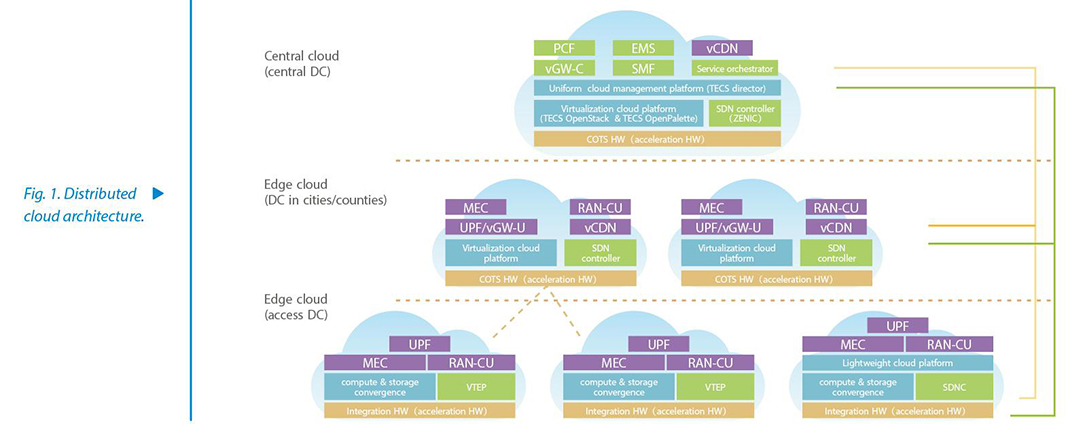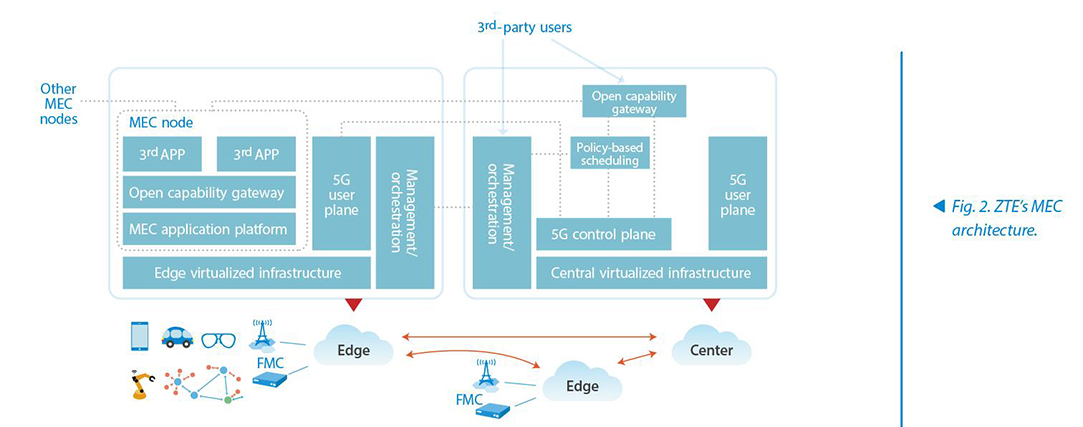The Rise of 5G-Oriented Edge Computing
5G signifies a shift in communication from man-to-man to man-to-machine and machine-to-machine. It would enable a wide range of services, including AR/VR, IoT, industrial automation and autonomous driving. This creates the requirements for high bandwidth, low latency and massive connections, which are the three major usage scenarios defined for 5G by 3GPP.
Edge Cloud Features
In order to meet the requirements of 5G services, more and more NEs start to separate the control plane from the forwarding plane, allowing for hierarchical deployment. The control plane is centralized and provides centralized scheduling while the user plane NEs are distributed close to the users, which helps strike a balance between management costs and user experience. Meanwhile, in order to effectively move service anchors towards the edge, shorten service response time and expose the communication capabilities of traditional mobile networks, mobile/multi-access edge computing (MEC) is fully introduced. To adapt to distributed NE deployment and MEC deployment, it is necessary to use cloudification technologies to transform a centralized telecom cloud into a distributed telecom cloud on the infrastructure level.
The distributed cloud (Fig. 1) is composed of central cloud and edge cloud (which can be subdivided into city, county and access levels). The central cloud, as the brain and center, mainly controls/manages centralized media-plane NEs. The edge cloud mainly bears distributed user plane/media plane NEs for fast traffic offloading as well as NEs with strict real-time requirements to develop a better user experience for services such as HD video, vehicle networking and VR/AR.

The edge cloud has the following features due to its particularity in location, scale and environment.
—Limited by the environment (e.g. air conditioners, bearing capacity and power), the edge cloud deployed in cities, counties and base stations usually adopt customized multi-node servers or hardware that integrates computing, storage and network. Such hardware, based on the universal X86 architecture, has high environmental adaptability and allows a cabinet to have the minimum height and depth. It features front maintenance, high integration and low power consumption, which matches existing equipment room conditions and reduces the room reconstruction requirements.
—With the arrival of 5G services, the edge cloud resource pool will evolve from a single resource pool type (VM/bare metal) to co-existence of multiple types (VM/bare metal and container). OpenStack and Kubernetes are two key technologies that unify the underlying network/storage/security technologies and enable unified orchestration and management of VM/container resources, greatly improving resource allocation flexibility and resource utilization ratio.
—The edge cloud, based on X86, usually introduces co-processors (accelerators) such as FPGAs and GPUs to meet the network’s high-speed forwarding requirements. The latest ETSI NFV architecture uses hardware acceleration. It adds acceleration resource virtualization capability, which abstracts accelerators, presents them as logical acceleration resources, and uniformly provides comprehensive acceleration services.
—Due to the small storage scale, the edge cloud adopts an independent resource pool, resulting in high costs and low resource utilization ratio. Therefore, the converged compute and storage solution is widely used, with distributed storage deployed in the compute nodes. The unification of compute and storage nodes greatly enhances resource utilization ratio. Meanwhile, VMs/containers on the local nodes can directly access the local storage through policy configuration and allow replication to other nodes, which greatly enhances storage performance while guaranteeing the reliability.
—Since the edge cloud has a small scale, it is necessary to reduce the resources occupied by the management module. It is viable to either deploy the lightweight management module or to centrally deploy the management module in the upper-layer cloud and only deploy compute nodes in the edge cloud. Both types of deployments can be chosen flexibly according to the scenarios.
—The distributed cloud usually adopts hierarchical deployment. Data centers are distributed at different locations and have multiple resource types, which requires a uniform management platform to hide the heterogeneity of resource pools and perform global O&M to improve Q&M efficiency.
MEC Scenarios and Architecture
As the technology for enabling the edge cloud, MEC extends IT and cloud computing capabilities to the edge of the network by deploying universal servers close to the access side. It allows distributed deployment and localization of applications, services and contents, makes low latency and high bandwidth transmission possible, and reduces the amount of backhaul bandwidth required and operation costs. Meanwhile, MEC defines a two-way API communication mechanism of network and third-party applications. For example, a wireless network can expose contextual information (e.g. location, network load, and wireless resources utilization ratio) to third-party applications via APIs, which effectively enhances the network’s intelligence and promotes deep convergence of network and services.
According to the features of different services, MEC application scenarios are divided into two types: one is localized services (e.g. local caching and integration of services) with typical application scenarios including enterprise park networks and extended AR/VR services; and the other is vertical market expansion with typical application scenarios including IoV and industrial internet. In order to better support new services and explore the existing network’s capabilities, MEC needs to address issues such as more precise indoor navigation, platform development and application integration.
Taking into consideration the MEC system architecture features specified by ETSI and 3GPP and requirements of 5G MEC scenarios, ZTE has designed an MEC architecture (Fig. 2).

Based on 5G distributed cloud infrastructure, 5G user planes and 5G MEC nodes are deployed in the edge cloud. The 5G MEC nodes provide an MEC application platform, which enables third-party applications and provides public services for third-party applications. MEC nodes cooperate with each other to support context transfers to guarantee service continuity during UE mobility.
The central side exposes network capabilities to third-party users and applications. Policy-based scheduling, according to application, load and network conditions, dynamically creates/deletes a third-party application instance, and dynamically provides policies for edge user plane function selection, achieving great coordination of network and services.
The architecture adopts a hierarchical management/orchestration structure. The management/orchestration function on the central side is the uniform entrance to the management and orchestration of third-party applications, which selects one or more edge locations to deploy applications. The management/orchestration on the edge side manages actual resources allocation and application deployment.
Summary
We should be prepared for the ICT-based convergence trend and 5G era. Different from the pipe provider in 4G era, the operator in 5G era stands a greater chance in exploring value-added services and transforming into an E2E service provider. As the new technology of ICT convergence, edge computing brings high bandwidth, low latency and localized services closer to the edge of the network. It provides uniform telecom infrastructure support for mobile and fixed convergence and will play an important role in digital transformation and industrial structure upgrade. However, it still needs to be supported by a strong business model. The industry has lots of expectation for various application scenarios of the edge service platform. ZTE hopes to join hands with more partners to discuss about the cooperation mode of MEC, build the ecosystem for 5G network edge, and promote the prosperous development of the edge service.